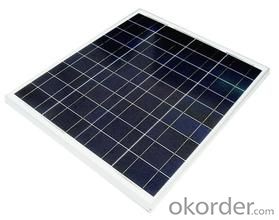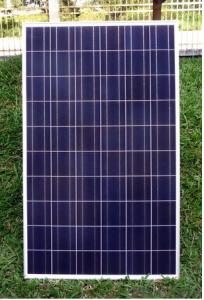CNBM Poly 175W Solar Panel with TUV UL CE Certificate For Residential
- Loading Port:
- Shanghai
- Payment Terms:
- TT OR LC
- Min Order Qty:
- 100 watt
- Supply Capability:
- 1000 watt/month
OKorder Service Pledge
OKorder Financial Service
You Might Also Like
Item specifice
CNBM Poly 170W Solar Panel with TUV UL CE Certificate For Residential
Introduction
Solar modules use light energy (photons) from the sun to generate electricity through the photovoltaic effect. The majority of modules use wafer-based crystalline silicon cells or thin-film cells based on cadmium telluride or silicon. The structural (load carrying) member of a module can either be the top layer or the back layer. Cells must also be protected from mechanical damage and moisture. Most solar modules are rigid, but semi-flexible ones are available, based on thin-film cells.

Suggested application
Home lighting business lighting,
Garden lighting, pavement lighting
Farmer household lighting
Decorative water pump
Traffic signal lighting
Industry area
Business area
Solar Power Plant
Product feature
Modules are made of Monocrystalline or Polycrystalline Silicon cell.
Materials and color of the solar panel frame: Clear anodized aluminum alloy type 6063T5 Universal frame; Silver-white color;
The output connection gathers the coupling: Selects conforms to the IEC-612615; 2005, class II, IEC61730 international standard; Airtight waterproofing binding clamp;
Module seal structure: The surface is thick, the high diaphanous rate armored glass with solar cell board special-purpose 3.2mm becomes after the high temperature lamination craft. The back selects has waterproof and anti- aged performance fine TPT materials. The entire block battery board has, the waterproofing, the anti- aging airtight and so on the fine performance;
Power tolerance: +/-3%
Packaging
International standard cartons (according to the requirements of customers)
- Q:I have heard a lot about solar panels and I want to know how these solar panels works and is it really possible to generate electricity using solar panels. And what is the cost of getting a solar panel installed?
- solar panels are a waste, I work for the biggest energy producer on the east coast and we are required by some really dumb laws to have many types of energy sources, fo course the only ones we make money on are coal and nuclear, solar panels we lose a ton of money on because they never make up for the cost it takes to buy them, and technology cannot bring them down because their too expensive even with a gov't subsidy bc of the products to make them. Don't waste your time with them, if you want to save money get a wood furnace
- Q:Can solar panels be installed on a parking lot or carport?
- Yes, solar panels can be installed on a parking lot or carport. In fact, these locations are ideal for solar panel installations as they provide ample space and can generate clean energy while also providing shade and protection for vehicles. This dual-purpose approach helps maximize the benefits of solar energy and optimizes land usage.
- Q:The average solar panel produces 0% of the energy that is put into it. What is happening to the other 90%? Is it being reflected or is it being obsorbed by materials that are not a part of the solar cell? Is it possible to one day have near 00% efficient solar cell technology?
- Mainly due to reflection (micro-structuring of the surface helps here), incorrect wavelength of the light (the panel is only sensitive to a certain wavelength range) and heating of the panel (due to the incident light/thermal radiation). The remainder is either reflected or absorbed by the cell and re-emitted as heat. Absorption by e.g. the glass panel is slight (a few %), as is absorption/reflection by the necessary surface contacts (again, a few %). Higher efficiency is possible, but brings its own drawbacks (like higher cost). You could now go into two directions: - high efficiency cells/panels with (likely) higher cost and complexity for mounting (like lens or mirror based systems, aka concentrator systems, that increase the light level on the cells in order to increase efficiency) - low cost systems (cheap as dirt) that will allow you to cover every surface of a building, efficiency is less important if you can compensate by a much larger covered area As to the efficiency limit: there is a theoretical limit (from thermodynamics - don't ask me how or why) in the range of 30...40%, depending on which publication you want to believe in.
- Q:Are solar panels environmentally friendly?
- Yes, solar panels are environmentally friendly. They produce clean, renewable energy by harnessing the power of the sun, reducing the reliance on fossil fuels and minimizing greenhouse gas emissions. Additionally, solar panels have a long lifespan and can be recycled at the end of their life, making them a sustainable and eco-friendly energy solution.
- Q:How much would solar panels cost for: A Cell phoneA average houseA car
- They would cost quite a bit but the user would likely be eligible for some energy credits from the power company and their cell phone carrier which would bring down the costs
- Q:What would it take to make a heater for a small solar panel. I am looking into making a heater for a livestock tank to keep ice melted. I know that heaters take alot of energy to run, but my theory is that if heated mirrors on a car can melt ice with low voltage and im sure not extreme heat (40-60 degrees) then making a heater with just high enough temperature to keep from icing over and melting ice is possible. Where do I start? I would like to use an inexpensive solar panel that will generate enough heat to keep ice from forming and melt it at the beginning of the day. How can you make such a heater and apply Ohms law so that it will function correctly, what Wattage will the pannel need to produce to generate enough heat for the heater. The device will only have to be large enough to melt a spot large enough for an animal to drink.
- Short answer is yes. Good to start out a large tank, or big rock to mount your collectors on. Something the stock won't eat or push over. I would start with a swimming pool solar collector. It is just a big piece of black plastic aimed at the winter sun. A collector with insulation and covers will give more heat per sq foot and cost more. Big mirrors and a black painted stock tank might be enough. Insulation of the tank might help a lot. Is the water liquid when pumped up the tank? Do you truck the water in? Is there any electric power wired there or near by? Electric solar collectors can pump and heat water and charge batteries, but it is also possible to circulate water using a thermosyphon set up. You don't have to use photocells. If it gets cold enough some collectors can freeze solid and damage themselves. There are collectors that contain two loops one water the other antifreeze.
- Q:What are solar panels?
- Solar panels are a collection of photovoltaic cells, that are used to generate electricity, from light. Here is the simple explanation from wikipedia, concerning photovoltaic cells . Photons in sunlight hit the solar panel and are absorbed by semiconducting materials, such as silicon. 2. Electrons (negatively charged) are knocked loose from their atoms, allowing them to flow through the material to produce electricity. The complementary positive charges that are also created (like bubbles) are called holes and flow in the direction opposite of the electrons in a silicon solar panel. 3. An array of solar panels converts solar energy into a usable amount of direct current (DC) electricity. Solar panels are used extensively for power generation in many places, but most space applications (like satellites and spacecraft) use solar panels. If you look at a picture of the current configuration of the International Space Station, the giant wing things are the solar panels.
- Q:Is there a cheaper way on how to make your own solar panels ? Can someone share their real life experience ? Thank you.
- If okorder / . Beware of anyone who makes claims you can save tons of money by making your own panels. Those are scams. It's possible to save money with solar, but not with homemade panels.
- Q:What specification of solar panel would I need to power a laptop every day? I would need to use it for about 0 hours or so every day. I don't know anything about solar panels, but I am seriously thinking of getting one now and don't know who to ask.
- Ive been employing the comparable photograph voltaic panels for 5 years, have flow some instances so as that they final lots longer than the roofs weve had over us. i'm coaching my young ones a thank you to construct wind turbines, because of the fact we shop having potential failiures whilst the wind blows. and recently its have been given very windy. I can charge banks of battery's and shop my place of work working from dc-ac converters.
- Q:How do solar panels affect the overall sustainability of a building?
- Solar panels positively affect the overall sustainability of a building by reducing reliance on non-renewable energy sources and decreasing carbon emissions. They generate clean and renewable energy from the sun, reducing the building's environmental footprint and contributing to a greener future. Additionally, solar panels can lower energy costs, increase energy efficiency, and provide energy independence, making the building more resilient and sustainable in the long run.
1. Manufacturer Overview |
|
|---|---|
| Location | |
| Year Established | |
| Annual Output Value | |
| Main Markets | |
| Company Certifications | |
2. Manufacturer Certificates |
|
|---|---|
| a) Certification Name | |
| Range | |
| Reference | |
| Validity Period | |
3. Manufacturer Capability |
|
|---|---|
| a)Trade Capacity | |
| Nearest Port | |
| Export Percentage | |
| No.of Employees in Trade Department | |
| Language Spoken: | |
| b)Factory Information | |
| Factory Size: | |
| No. of Production Lines | |
| Contract Manufacturing | |
| Product Price Range | |
Send your message to us
CNBM Poly 175W Solar Panel with TUV UL CE Certificate For Residential
- Loading Port:
- Shanghai
- Payment Terms:
- TT OR LC
- Min Order Qty:
- 100 watt
- Supply Capability:
- 1000 watt/month
OKorder Service Pledge
OKorder Financial Service
Similar products
New products
Hot products




























